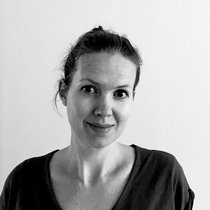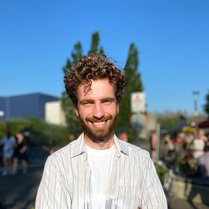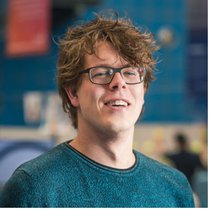Although dealing with traveling restrictions, social distancing, and the accompanying delays - it was still possible to run the experiments - all within guidelines - and some of the projects developed at a rapid speed. Despite all these restrictions, Marineterrein Amsterdam Living Lab (MALL) was in full swing.
By Yemoï Hoeben – Communications Intern at AMS Institute
Marineterrein Amsterdam Living Lab uses the terrain as an experimental environment for its own development. Together with Marineterrein Amsterdam, Amsterdam Smart City and NEMO Science Museum– we work together to encourage collaboration between companies, scientists, students and governmental agencies, leading to (scalable) experiments that are tested on the grounds, and ultimately applied in urban environments.
Currently, AMS Institute is involved in five projects within the living lab: Roboat, Space For Food, Respyre, Responsible Sensing Lab, and Husky. For more information, download this flyer.
“Living Labs are an attractive way to test, create and develop metropolitan solutions that will be adopted more smoothly and swiftly by all stakeholders involved.”
Angelina Kroft | Project Coordinator Living Lab | Marineterrein Amsterdam

Roboat
The past six months the Roboat team made great progress. First of all, they reached a new milestone on April 30, when Deputy Mayor Everhardt officially put the new slewing crane at Marineterrein Amsterdam into operation. This marks a new phase, in which the team is able to perform tests with the full-scale prototype of Roboat at the inner harbors of the Marineterrein Amsterdam.
Secondly, with the arrival of the new garbage module, the team is taking serious steps in the development of possible use cases. Roboat aims to become an autonomous and modular vehicle which will be used to tackle metropolitan challenges like garbage waist and transport. We held an interview with the design engineer of Roboat, Pietro Leoni and talked about the specific design choices that are made during the development of the full-scale prototype.
The developments over the past few months did not go unnoticed. Associated Press visited the Roboat team at the Marineterrein and made an item about the new testing fase. This got picked up globally.
Here is a selection of our favorite articles:
www.theguardian.com
www.thecourier.co.uk
www.welt.de
Roboat is a collaboration between AMS Institute and MIT Senseable City Lab.
“The past six months at Roboat were positively marked by the first successful tests with autonomous sailing at the Marineterrein. We experienced the amazing feeling of sailing on a self- steering boat.”
Rens Doornbusch
Former Mechatronics Engineer Roboat at AMS Institute

Space For Food
Finally, in February the great news reached us that the ‘test lab’ container had arrived at Marineterrein Amsterdam. This was the starting signal for the project Space for Food, which examines the wastewater from the local brewery and the municipality of Amsterdam that will be used for the cultivation of purple bacteria in raceway reactor.
The researcher who is responsible for the operation of the pilot plant is Tabea Hertel. Sjoerd Ponstein from Bureau Marineterrein wrote an interview with her in which she explains the goal of the research and how it can contribute to a more circular and sustainable city environment.
Space for Food is coordinated by SEMiLLa IPStar (European Space Agency)
“The only sustainable solution is circularity and reusing as many materials as possible until we no longer need to use new raw materials.”
Tabea Hertel | Researcher | Space For Food

Respyre
Respyre has developed and patented a new bio-receptive concrete product, which – when applied to existing structures like concrete – facilitates spontaneous growth of moss. They started in early January of this year with the check- up of the concrete wall located at Marineterrein Amsterdam where they wanted to test the product.
After collecting the moss from dilapidated buildings, they started with the application to the wall the beginning of March.
Four months went by, and the moss is really starting to grow. Do you like to keep an eye on the wall yourself? Go to The Marineterrein in Amsterdam and find the wall. A tip: it is hidden nearby the Commandantswoning.
Would you like to read more about Respyre? In an interview with Auke Bleij (Business and Technology Developer) he tells the story, future plans and dreams of the company. The interview is written by Sjoerd Ponstein from Bureau Marineterrein.
“From the lab to the real world, that's a big step. On the Marineterrein, we were given the space to test the potential of Respyre's technology in the built environment. After some adjustments, we now see what we hoped for: the development of a vertical garden, wonderful!”
Auke Bleij | Business and Technology Developer | Respyre

Responsible Sensing Lab
The Responsible Sensing Lab team had an exited half year with lots of developments.
Firstly, they installed the sensors of The Shuttercam Project at The Marineterrein in April. In total three sensors were installed at different locations, so they were able to start testing and collecting data.
The Shuttercam project originated based on the notion that citizens currently can not directly know or see if and when cameras in public space are monitoring you or not. They are experimenting how citizens react if cameras are equipped with shutters showing us when the camera ‘sees’ you or not. The project also questions the necessity for many non-security related cameras in the city to be switched on indefinitely.
In June, the RSL Research Assistant Sjoerd Verhagen, analyzed the first findings of the sensors by conducting interviews with visitors of Marineterrein Amsterdam.
Sjoerd interviewing visitors of The Marineterrein
Would you like to know more about the Responsible Sensing Lab? Visit 'Senses of Amsterdam' in the exhibition Project Tomorrow, in The Studio of NEMO. Here you can see the Senses of Amsterdam which is an interactive installation about the sensors in the city.
The Responsible Sensing Lab is a collaboration between AMS Institute and Gemeente Amsterdam
Senses of Amsterdam
“By researching the Shuttercam project, it became clear that it is important to do further research on how to communicate the purpose of sensors to the public. This insight has shown the Responsible Sensing Lab that there is a need to address questions regarding who is collecting the data, what exactly is collected and for what purposes.”
Sjoerd Verhagen
Research Assistant
Husky
The Husky is a mobile robot platform that help us evoke and understand the reactions of people against sidewalk robots. The main question of the project is: how can we design the behaviours of robots such that they are at home in our cities? The project will generate new insights in the potential of sidewalk robots, and the specific challenges they need to overcome to become embedded in the city. The interaction of humans with robots is the centralized topic in the project.
Exited things are coming for the Husky because multiple master theses are currently being written about the project which will add great value to the overall research.
If you are lucky, you will spot the Husky roaming around at Marineterrein Amsterdam, mostly on Fridays.
But why are such robots great value to a society, especially in metropolitan area’s? We asked Project Lead Jered Vroon to tell us more during an interview. Here he explains the functionalities, benefits, challenges and future goals of the project. This interview will be published soon.
The Husky project is an idea from Delft University of Technology
“While roaming with the Husky on Marineterrein, people are reacting to the robot in a surprisingly natural way. We are curious to learn more about the interaction between humans and robots.”
Jered Vroon
Social Interaction Dynamics
----
Would you like know the exact locations of all the MALL Projects? Download the Meli App for Apple and Google.
Meli App is part of the AMS Start Up Booster.

